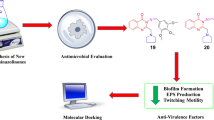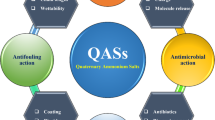Abstract
In this study, we investigated a new series of naphthalimide based Schiff base compounds as potential DNA binding, antioxidant and antimicrobial agents. The structural characterization of synthesized compounds was carried out with the aid of elemental analysis and spectroscopic techniques (UV–vis., IR, 1H and 13C NMR). The DNA binding properties of target compounds against Ct-DNA (calf thymus) have been investigated in detail by numerous biophysical techniques (UV–vis, fluorescence, ethidium bromide displacement assay, Time resolved fluorescence, viscosity, cyclic voltammetry and circular dichorism) and the evidences have suggested that the test compounds could interact with DNA via intercalative binding. The extent of DNA binding (Kb) of these compounds follow the order of 3b (3.33 × 104 M−1) > 3a (2.25 × 104 M−1) > 3c (2 × 104 M−1), suggesting that compound 3b binds more strongly to Ct- DNA than the compounds 3a and 3c. Molecular docking results further support intercalative binding of test compounds with DNA. The binding energies of docked compounds (3a-3c) were found to be −8.20 to −8.69 kcal/ mol, suggesting greater binding affinity to Ct-DNA. The synthesized compounds displayed potential antimicrobial activities against Escherichia coli, Staphylococcus aureus, Klebsiella pneumoniae and Salmonella typhimurium. Compound 3c has emerged as most active against all the four tested bacterial strains with MIC value in the range of 0.031–0.062 mg/mL. In the mutagenicity studies, all the test compounds were found to be non-mutagenic both in the presence and absence of metabolic activation. Furthermore, the antioxidant activity experiments show that these compounds exhibited potential scavenging activities against DPPH and H2O2 radicals.











Similar content being viewed by others
References
Chen Z, Liang X, Zhang H, Xie H, Liu J, Xu Y, Zhu W, Wang Y, Wang X, Tan S, Kuang D, Qian X (2010) A new class of naphthalimide-based antitumor agents that inhibit Topoisomerase II and induce lysosomal membrane permeabilization and apoptosis. J Med Chem 53:2589–2600
Fuente RDL, Sonawane ND, Arumainayagam D, Verkman AS (2006) Small molecules with antimicrobial activity against E. coli and P. aeruginosa identified by throughput screening. Br J Pharmacol 49:551–559
Tischer M, Sologub L, Pradel G, Holzgrabe U (2010) The bisnaphthalimides as new active lead compounds against Plasmodium falciparum. Bioorg Med Chem 18:2998–3003
Xu Y, Qian X, Yao W, Mao P, Cui J (2003) Novel naphthalimide hydroperoxide Photonucleases: the role of Thiocyclic-fused area and the difference in spectra, photochemistry and photobiological activity. Bioorg Med Chem 11:5427–5433
Qian X, Li Y, Xu Y, Liu Y, Qu B (2004) Highly-efficient DNA photocleavers with long wavelength absorptions: thio-heterocyclic fused naphthalimides containing aminoalkyl side chains. Bioorg Med Chem Lett 14:2665–2668
Ingrassia L, Lefranc F, Kiss R, Mijatovic T (2009) Naphthalimides and azonafides as promising anti-cancer agents. Curr Med Chem 16:1192–1213
Gregor KAM, Robertson MJ, Young KA, Kleist LV, Stahlschmidt W, Whiting A, Chau N, Robinson PJ, Haucke V, Mc Cluskey A (2014) Development of 1, 8-Naphthalimides as Clathrin Inhibitors. J Med Chem 57:131–143
Cao H, Chang V, Hernandez R, Heagy MD (2005) Matrix screening of substituted N-Aryl-1,8-naphthalimides reveals new dual fluorescent dyes and unusually bright pyridine derivatives. J Org Chem 70:4929–4934
Duke RM, Gunlaugsson T (2007) Selective fluorescent PET sensing of fluoride (F) using naphthalimide–thiourea and –urea conjugates. Tetrahedron Lett 48:8043–8047
Gan J, Song QL, Hou XY, Chen K, Tian H (2004) 1,8-Naphthalimides for non-doping OLEDs: the tunable emission color from blue, green to red. J Photochem Photobiol A Chem 162:399–406
Zhang YY, Zhou CH (2011) Synthesis and activities of naphthalimide azoles as a new type of antibacterial and antifungal agents. Bioorg Med Chem Lett 21:4349–4352
Brana MF, Cacho M, Garcia MA, Pascual-Teresa B, Ramos A, Dominguez MT, Pozuelo JM, Abradelo C, Rey-Stolle MF, Yuste M, Banez-Coronel M, Lacal JC (2004) New analogues of amonafide and elinafide, containing aromatic heterocycles: Synthesis, antitumor activity, molecular modeling, and DNA binding properties. J Med Chem 47:1391–1399
Li Y, Yang ZY, Wang MF (2009) Synthesis, characterization, DNA binding properties and antioxidant activity of Ln(III) complexes with hesperetin-4-one-(benzoyl) hydrazone. Eur J Med Chem 44:4585–4595
Kashanian S, Javanmardi S, Chitsazan A, Paknejad M, Omidfar K (2012) Fluorometric study of fluoxetine DNA binding. J Photochem Photobiol B 113:1–6
Tong C, Xiang G, Bai Y (2010) Interaction of paraquat with Calf thymus DNA: a Terbium (III) luminescent probe and multispectral study. J Agric Food Chem 58:5257–5262
Guo H, Cai C, Gong H, Chen X (2011) Multi-spectroscopic method study the interaction of anti-inflammatory drug ketoprofen and calf thymus DNA and its analytical application. Spectrochimic Acta Part A A79:92–96
Kalanur SS, Katrahalli U, Seetharamappa J (2009) Electrochemical studies and spectroscopic investigations on the interaction of an anticancer drug with DNA and their analytical applications. J Electroanal Chem 636:93–100
Oehlers L, Mazzitelli CL, Brodbelt JS, Rodriguez M, Kerwin S (2004) Evaluation of complexes of DNA duplexes and novel benzoxazoles or benzimidazoles by Electro spray ionization mass spectrometry. J Am Soc Mass Spectrom 15:1593–1603
Jangir DK, Charak S, Mehrotra R, Kundu S (2011) FTIR and circular dichroism spectroscopic study of interaction of 5-fluorouracil with DNA. J Photochem Photobiol B 105:143–148
Cusumano M, Pietro MLD, Giannetto A, Nicolo F, Rotondo E (1998) Noncovalent interactions of Platinum (II) square planar complexes containing ligands out-of-plane with DNA. Inorg Chem 37:563–568
Vijesh AM, Isloor AM, Telkar S, Arulmoli T, Fun HK (2013) Molecular docking studies of new imidazole derivatives for antimicrobial properties. Arabian J Chem 6:197–204
Xie L, Xu Y, Wang F, Liu J, Qian X, Cui J (2009) Synthesis of new amonafide analogues via coupling reaction and their cytotoxic evaluation and DNA-binding studies. Bioorg Med Chem 17:804–810
Zhao L, Li J, Li Y, Liu J, Wirth T, Li Z (2012) Selenium-containing naphthalimides as anticancer agents: design, synthesis and bioactivity. Bioorg Med Chem 20:2558–2563
Mortelmans K, Zeiger E (2000) The Ames Salmonella/microsome mutagenicity assay. Mutat Res 455:29–60
Arriaga-Alba M, Ruiz-Pérez NJ, Sánchez-Navarrete J, López de Angel B, Flores-Lozada J, Blasco JL (2013) Antimutagenic evaluation of vitamins B1, B6 and B12 in vitro and in vivo, with the Ames test. Food Chem Toxicolol 53:228–234
Vicini P, Geronikaki A, Incerti M, Busonera B, Poni G, Cabras CA, Colla PL (2003) Synthesis and biological evaluation of Benzo[d]isothiazole, Benzothiazole and Thiazole Schiff bases. Bioorg Med Chem 11:4785–4789
Cheng K, Zheng QZ, Hou J, Zhou Y, Liu CH, Zhao J, Zhu HL (2010) Synthesis, molecular modeling and biological evaluation of PSB as targeted antibiotics. Bioorg Med Chem 18:2447–2455
Karthikeyan MS, Prasad DJ, Poojary B, Bhat KS, Holla BS, Kumari NS (2006) Synthesis and biological activity of Schiff and mannich bases bearing 2, 4-dichloro-5-fluorophenyl moiety. Bioorg Med Chem 14:7482–7489
Kumar KS, Ganguly S, Veerasamy R, Clercq ED (2010) Synthesis, antiviral activity and cytotoxicity evaluation of Schiff bases of some 2-phenyl quinazoline-4(3)H-ones. Eur J Med Chem 5:5474–5479
Pu-Su Z, Jie S, Xiao-Jun S, Li D, Fang-Fang J (2011) Syntheses, crystal structures and property studies on Cu(II) and Co(II) complexes with 1,8-Naphthalimide Schiff base Chinese. J Struct Chem 30:346–353
Arish D, Nair MS (2011) Synthesis, spectroscopic, antimicrobial, DNA binding and cleavage studies of some metal complexes involving symmetrical bidentate N, N donor Schiff base ligand. Spectrochim Acta A 82:191–199
Anbu S, Kandaswamy M (2011) Electrochemical, magnetic, catalytic, DNA binding and cleavage studies of new mono and binuclear copper(II) complexes. Polyhedron 30:123–131
Ghosh S, Banik D, Roy A, Kundu N, Kuchlyan J, Sarkar N (2014) Spectroscopic investigation of the binding interactions of a membrane potential molecule in various supra molecular confined environments: contrasting behavior of surfactant molecules in relocation or release of the probe between nano carriers and DNA surface. Phys Chem Chem Phys 16:25024–25038
Rajendiran V, Murali M, Suresh E, Palaniandavar M, Periasamy VS, Akbarsha MA (2008) Non-covalent DNA binding and cytotoxicity of certain mixed-ligand ruthenium(II) complexes of 2,2 -dipyridylamine and diimines. Dalton Trans. 2157–2170
Miliauskas G, Venskutonis PR, Beek TAV (2004) Screening of radical scavenging activity of some medicinal and aromatic plant extract. Food Chem 85:231–237
Ruch RJ, Cheng SJ, Klaininig JE (1980) Prevention of cytotoxicity and inhibition of intracellular communication by antioxidant catechins isolated from Chinese green tea. Carcinogen 10:1003–1008
Maron DM, Ames BN (1983) Revised methods for Salmonella mutagenicity test. Mutat Res 113:175–215
Wang R, Fu Y, Lai L (1997) A new atom-additive method for calculating partition coefficients. J Chem Inf Comput Sci 37:615–621
Lipinski CA, Lombardo F, Dominy BW, Feeney PJ (1997) Experimental and computational approaches to estimate solubility and permeability in drug discovery and development setting. Adv Drug Deliv Rev 23:3–25
Veber DF, Johnson SR, Cheng HY, Smith BR, Ward KW, Kapple KD (2002) Molecular properties that influence the oral bioavailability of drug candidates. J Med Chem 45:2615–2323
Wolfe A, Shimer GH, Meehan T (1987) Polycyclic Aromatic hydrocarbons physically intercalate into duplex regions of denatured DNA. Biochemistry 26:6392–6396
Barton JK, Danishefsky AT, Goldberg JM (1984) Tris(phenanthroline) ruthenium(II): stereo selectivity in binding to DNA. J Am Chem Soc 106:2172–2176
Shah A, Zaheer M, Qureshi R, Akhter Z, Nazar MF (2010) Voltammetric and spectroscopic investigations of 4-nitrophenylferrocene interacting with DNA. Spectrochim Acta A 75:1082–1087
Arjmand F, Muddassir M, Yousuf I (2014) Design and synthesis of enantiomeric (R) and (S)-copper (II) and diorganotin(IV)-based antitumor agents: Their in vitro DNA binding profile, cleavage efficiency and cytotoxicity studies. J Photochem Photobiol B 136:62–71
Arjmand F, Yousuf I, Hadda T, Toupet L (2014) Synthesis, crystal structure and anti proliferative activity of Cu(II) nalidixicacide DACH conjugate: Comparative in vitro DNA/RNA binding profile, cleavage activity and molecular docking studies. Eur J Med Chem 81:76–88
Sowrirajan C, Yousuf S, Vijayaraj MVEI (2014) Binding of flavanone with-CD/ct-DNA: a spectroscopic investigation. Turk J Chem 38:725–738
Kypr J, Kejnovska I, Renciuk D, Vorlıckova M (2009) Circular dichroism and conformational polymorphism of DNA. Nucleic Acids Res 37:1713–1725
Jose D, Porschke D (2004) Dynamics of the B-A transition of DNA double helices. Nucleic Acids Res 32:2251–2258
Sigman DS, Mazumder A, Perrin DM (1993) Chemical nucleases. Chem Rev 93:2295–2316
Wang B, Yang ZY, Crewdson P, Wang D (2007) Synthesis, crystal structure and DNA-binding studies of the Ln (III) complex with 6-hydroxychromone-3-carbaldehyde benzoyl hydrazone. J Inorg Biochem 101:1492–1504
Chu X, Shen GL, Jiang JH, Kang TF, Xiong B, Yu RQ (1998) Voltammetric studies of the interaction of daunomycin anticancer drug with DNA and analytical applications. Anal Chim Acta 373:29–38
Aslanoglu M (2006) Electrochemical and spectroscopic studies of the interaction of Proflavine with DNA. Anal Sci 22:439–443
Latha P, Kodisundaram P, Sundararajan ML, Jeyakumar T (2014) Synthesis, characterization, crystal structure and theoretical study of a compound with benzodiazole ring: antimicrobial activity and DNA binding. Spectrochim Acta Part A 129:429–437
Erena Y, Özata A (2014) Determination of mutagenic and cytotoxic effects of Limonium globuliferum aqueous extracts by Allium, Ames, and MTT tests. Rev Bras Farmacogn 24:51–59
Acknowledgments
The authors thank to University Grant Commission, New Delhi for financial support through Major Research Project (F.No. 41-238/2012) and Mr. Pattan Sirajuddin. Nayab is also thankful to UGC for meritorious BSR Fellowship.
Author information
Authors and Affiliations
Corresponding author
Ethics declarations
Conflict of Interest
The authors confirm that this article content has no conflict of interest.
Electronic supplementary material
Below is the link to the electronic supplementary material.
ESM 1
(DOC 1405 kb)
Rights and permissions
About this article
Cite this article
Nayab, P.S., Pulaganti, M., Chitta, S.K. et al. Evaluation of DNA Binding, Radicals Scavenging and Antimicrobial Studies of Newly Synthesized N-Substituted Naphthalimides: Spectroscopic and Molecular Docking Investigations. J Fluoresc 25, 1905–1920 (2015). https://doi.org/10.1007/s10895-015-1683-1
Received:
Accepted:
Published:
Issue Date:
DOI: https://doi.org/10.1007/s10895-015-1683-1




